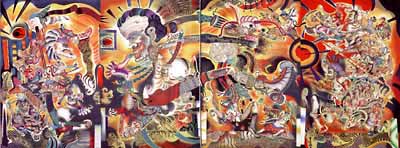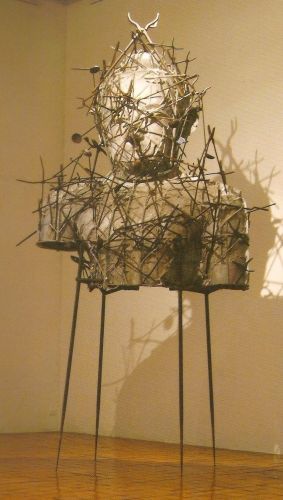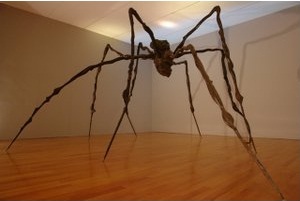藝評
Bangkok Smiles All Over Hong Kong
約翰百德 (John BATTEN)
at 5:34pm on 11th November 2011



Captions:
1. Montien Boonma, Melting Void: Molds for the Mind.
2. Prasong Luemuang, Animal Intercourse (Reflection on May Tragedy).
3. Kamin Lertchaiprasert, Sitting (Money) Series.
4. Louise Bourgeois, Spider.
(原文以英文發表,評論曼谷藝術及文化中心之開幕展《Traces of Siamese Smile》。)
If this expansive inaugural exhibition, Traces of Siamese Smile, is a taste of future exhibitions then the new Bangkok Art and Cultural Centre could become one of the most exciting contemporary arts venues in Asia. Organised by respected Thai curator Apinan Poshyananda, this survey comprising 109 international and Thai artists explores the Thai character through the motif of the enigmatic Thai smile; most commonly seen in the myriad images of Buddha found throughout the country. 1
Almost to emphasize that a smile can be everything from mischievous to cruel, I had twice walked out of Sakarin Krue-on’s Balance of Terror installation, as I had not seen anything in the pitch-black darkness. Possibly I had missed something subtle?
I again ventured back inside the small room that housed nothing except a ladder - was that part of the artwork? Read, but did not comprehend, the sign that simply said: “do not walk on the installation”; thinking, yes it is the installation that I want to see. I noticed some soiled blackened tissue paper screwed up on the floor; was that part of the artwork? I walked two more metres and my left foot suddenly plunged into what I immediately realised was a pool of murky black oil; slipped and grabbed the wall, slipped again and somehow avoided falling in. My right foot had miraculously, amongst all the slipping, remained dry. I slid back to the entrance of the installation and a few minutes later a security guard laughed and smiled at me. I had walked on the installation.
I was not amused.
I was kindly given lots of tissue paper to soak up the oil, but my left shoe and jeans were ruined (in a misplaced attempt to salvage something, I slid back towards the ‘installation’ and threw my brown right shoe back into the murk so it would, at least, be black like its pair). 2
A few hours later, I smiled.
Designed by Bangkok-based Thai/American architectural firm Robert G. Boughey & Associates, the 11-storey Bangkok Art and Culture Centre features an arts research library and computers, a reading/playroom for small children, theatres and meeting rooms plus a three-level shopping centre offering an income-flow to supplement the top three gallery floors. The Centre has a huge natural light-filled central atrium with spiral walkways linking each of these upper level gallery spaces and reminiscent in design to the Solomon R. Guggenheim Museum in New York.
Apart from faith and religion Traces of Siamese Smile covers a variety of observations about politics, love, society and art itself.
Modern Thai history has seen countless public protests calling for democracy and expressing frustration over official corruption, poverty and inequality. The suppression by police and the military of protests in 1973, 1976 and 1992 - and most recently in October 2008 - saw shocking scenes of brutality and death that have inspired many of the paintings seen in the exhibition: the Siamese smile hides both the repressed resentments of the masses and an official largesse that can turn into a brutal snarl of death.
The 5-metre long tableaux folk painting, Animal Intercourse (Reflection on the May Tragedy), by Prasong Luemuang combines the demand for democratic self-determination with the urges of animalistic sexual desire; a thin line of self-control easily tipped into a confused orgy of both violence and passion.
Offering a basis for living are the maxims of the Buddhist Dharma - a roadmap reminding us how we should live, think and behave. Kamin Lertchaiprasert’s Sitting (Money) series uses returned stocks of money shredded by Thailand’s Central Bank. The resulting moulded and papier-mâché sculpture and text uses various images of a sitting Buddha to express the message of the Dharma: “suffering exists, but it is not in the mind”; “the most truthful word is wordless”; “why worry, why be anxious”; “considering the body and letting it be”. These simple messages are a comfort during the current financial crisis, but you wonder that if they had been universally embraced as a balanced strategy for life our current financial and environmental woes might have been avoided.
Scattered throughout the exhibition is the light humour of Wasinburee Supanichvoraparch’s ceramic dogs, loin-clothed boys, and garden gnomes venerating Buddhist and secular icons; they induce a smile from the viewer and remind us of the virtues of a simple life. Montien Boonma’s Buddha’s head takes on the monumental look of Mao by simply encasing it in scaffolding and propping it up on stilts.
The work of Pierre et Gilles, Yue Minjun, Andy Warhol, Jean-Michael Basquiat, Nara Yoshitomo, Araki Nobuyoshi, Paolo Canevari and other overseas artists are included in the exhibition and outstanding is Louise Bourgeois’s famous Spider – its super size tentacle legs create a tension with its comparatively small but ominous looking mouth and torso. Marina Abramovic’s video, Sea Punishing, shows the artist kneeling at the edge of the sea as the tide comes in; the waves lash and inundate her but she remains calm and tight-lipped - her face stoic and Buddha-like.
From an initial idea in 1997 to its soft opening a few months ago, the Centre has been controversial and mirrors much of the debate surrounding Hong Kong’s West Kowloon Cultural District and the balance between public and corporate funding to build and run it. A proposal for the Centre to be run as a purely commercial-business entity was loudly condemned by Bangkok’s art community and after prolonged wrangling the Bangkok Metropolitan Administration eventually committed the initial 509 million baht (HK$125 million) capital funding to build the Centre and agreed to partially cover its operating expenses.
Hong Kong could benefit from looking at Bangkok’s experience. The members of the West Kowloon Cultural District Authority have just been appointed; mostly high profile members of the establishment with few links to contemporary art and culture. The Authority’s Chairman, Henry Tang Ying-yen says that the various venues will be run by separate ‘”boards” – but the legal and management structure of these boards has not been explained. 3 In contrast, the Bangkok Art & Culture Centre is run by an independent foundation with a board comprising a mixture of committed art-lovers, artists and business leaders led by a contracted executive Director.
The recently enacted West Kowloon Cultural District Ordinance indicates that the WKCD Authority will itself be involved in the programming of the WKCD facilities. Furthermore, and this will surely haunt future generations, there is no guarantee of artistic independence enshrined in the ordinance for groups using West Kowloon’s cultural facilities.
Most informed art and cultural commentators argue that West Kowloon’s M+ museum should be independently managed and run. How will M+ be independent? The initial planning for M+ has started and curatorial staff from the museums section of the Leisure & Cultural Services Department are now employed by the Home Affairs Bureau to begin the work of M+. Is this the beginning of M+ independence?
For M+ to be capable of replicating the type of exciting and relevant exhibition as Bangkok’s Art & Cultural Centre’s Traces of Siamese Smile questions about its management and independence need to be answered immediately. The money is there to build West Kowloon, but we are still awaiting an indication that there is the necessary passion that makes art venues great. As the Dharma says: “God is in the details”.
Notes:
1. The Bangkok Art & Culture Centre is free of charge and located in Bangkok’s busy Siam shopping precinct next to the National Stadium Skytrain station. The exhibition is complemented by an excellent website with a virtual tour and the video clip showing the assembling of Bourgeois’ Spider with accompanying epic music will induce a smile on even the most demanding of viewers.
See: www.siamesesmile2008.com
2. A fruitless attempt, the two shoes still sit sticky and stinking of oil in the same spot I threw them on my stairwell after I arrived back from Bangkok!
3. Henry Tang Ying-yen, interviewed by Vivienne Chow, “Hub to be ‘regional and not micromanaged’”, in South China Morning Post, 27 October 2008, p. 4.
Exhibition: Traces of Siamese Smile: Art+Faith+Politics+Love
Date: 24.9.2008 – 26.11.2008
Venue: Bangkok Art and Cultural Centre
Originally published in C for Culture, 9 November 2008.
